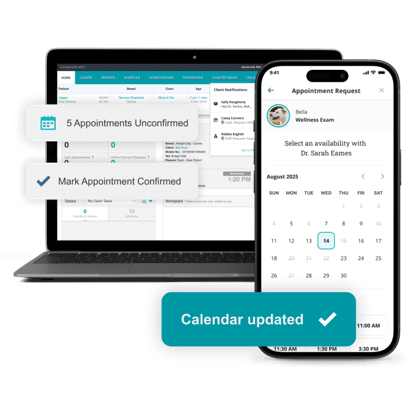5 Ways to Use Client Communication Automation in Veterinary Practice

Veterinary teams are busy, and adding client communication tasks, such as appointment reminders, follow-ups, and prescription refill notifications, can bog down staff members whose time could be better spent on pet care and animal health management tasks.
Client communication automation can take these tasks off your veterinary team’s plate. Automation also provides consistency for pet owners, helping you strengthen client relationships and loyalty.
Here are five practical ways your veterinary practice can automate communication, along with sample automated messages to get you started.
1. Appointment reminders and confirmations
Missed appointments can disrupt workflows, which can negatively impact team flow and the client experience. Automated reminders and confirmations reduce no-shows by communicating through platforms clients prefer to a phone call.
Use your practice management system’s built-in communication tools or third-party cloud-based integrations to send text messages (SMS), emails, or app notifications at key intervals leading up to an appointment. You can also include pre-visit instructions specific to the appointment type and links to check in, cancel, or reschedule the appointment.
You will likely need to create several variations of your reminder message that are personalized and provide specific pre-visit instructions (e.g., fasting or sample collection). Here’s an example of a simple automated appointment reminder:
Hi [Client Name], we’re reminding you about [Pet Name]’s appointment at [Practice Name] scheduled for [Date/time]. Reply YES to confirm or click here [link] to reschedule. We look forward to seeing you and [Pet Name] for [service].
2. Post-visit follow-up messages
Following up shows clients that you genuinely care about their pet and your role in their well-being. Post-visit messaging is a simple communication strategy that builds trust, improves client retention, promotes client engagement, and supports better pet health.
Leverage your PIMS and team to create client communication automations that fit your practice philosophy. For most visits, surgeries, and procedures, a 24-hour check-in is best. Longer-term condition management will likely require more frequent check-ins, which may not lend themselves well to automation. However, you can use your PIMS to generate reminders your veterinarian can use to reach out personally.
Here’s an example follow-up automation for a routine non-surgical visit:
Hi [Client Name], we hope [Pet Name] is doing well after their recent visit to [Practice Name]. If you have any questions about home care instructions or concerns about [Pet Name], please reach out by replying to this message or calling [phone number]. We’re here to help with anything you need as your partners in [Pet Name]’s care.
3. Prescription administration and refill reminders
Compliance with long-term treatment plans and parasite control programs requires clients to refill prescriptions on time. Waiting until the last minute puts undue stress on the team and jeopardizes patient care.
Rather than relying on busy pet owners, take proactive action to automate prescription reminders or use an online pharmacy platform to set up auto-fill services that take the guesswork out of medications and prescription diets. The online pharmacy platform should integrate with your practice management system to reduce manual data entry.
Here’s an example client communication automation regarding a prescription or preventive medication refill:
Hi [Client Name], we’re writing to let you know [Pet Name] may be running low on [medication name]. Click here [link] to visit our online pharmacy or call [phone number] to speak with a team member regarding [Pet Name]’s prescription refill.
4. Wellness service reminders
Keeping pets up to date on vaccinations, parasite prevention, and routine wellness visits is key for improving pet health outcomes and also creates touchpoints that nurture client relationships.
Automate notifications to let clients know about upcoming services and provide a booking link so they can act immediately with online appointment scheduling. If clients must call to schedule, the reminder becomes less effective because they may forget to follow up later.
Here’s an example client communication automation regarding vaccines:
Vaccinations are a critical component of your pet’s healthcare. Our records show that [Pet Name] will be due for [vaccines/services] on [Date]. To prevent a lapse in protection, click here [link] or call [phone number] to book a visit. You can also view all of [Pet Name]’s vaccination records in your patient portal—click here [link] to log in!
5. Boarding and surgery updates
Pet parents may feel anxious leaving their pet at the clinic for procedures or boarding stays. Real-time updates keep clients informed about changes, such as when a pet wakes up after surgery or a scheduled service is completed. While you may not be able to automate all of these communications, you can use automation to hold clients over.
For example, when you change the pet’s status on your virtual whiteboard from “in surgery” to “in recovery,” you can set up an automated message that lets clients know about the status change. Then, when the pet is fully awake, you can send more detailed information or call the client.
Here’s an example client communication automation for status changes:
Hi [Client Name], [Pet Name]’s procedure at [Practice Name] is complete, and they’re resting comfortably in recovery. We will provide a more detailed update soon!
Implementing client communication automation can simplify interactions between clients and pet owners. Choose communication tools that integrate seamlessly with your cloud-based practice management software, or upgrade to a new system that includes a built-in communication platform.
Automation doesn’t replace connection, but it can free your team from time-consuming administrative burdens and help your veterinary practice thrive.




